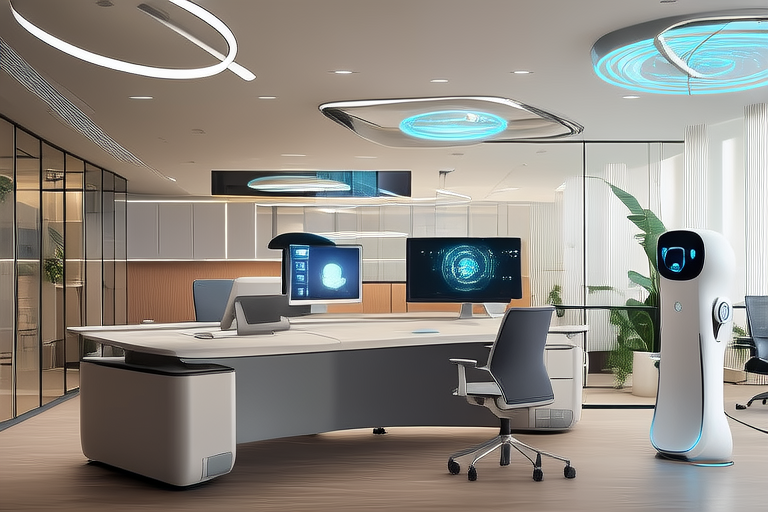10 Best Office Technology Trends That Will Transform Your Workspace in 2023
Introduction
In today’s fast-paced business environment, staying ahead of the curve is crucial for maintaining productivity and efficiency. The rapid advancement of technology has opened up new possibilities for transforming workspaces, making them more flexible, collaborative, and user-friendly. In 2023, several emerging trends promise to revolutionize how we work. From smart office solutions to cutting-edge communication tools, these innovations will not only enhance productivity but also improve employee satisfaction. Let’s dive into the top 10 office technology trends that will shape the future of your workspace.
1. AI-Powered Virtual Assistants
Artificial intelligence (AI) continues to evolve, offering increasingly sophisticated virtual assistants that can handle a wide range of tasks. These intelligent agents can schedule meetings, manage calendars, answer emails, and even provide real-time translations. By automating routine administrative duties, AI-powered virtual assistants free up valuable time for employees to focus on higher-level tasks. For example, imagine a scenario where an AI assistant automatically schedules meetings based on availability, ensuring minimal disruption to daily workflow. This technology is particularly beneficial for large organizations with complex scheduling needs.
Key Features:
- Natural Language Processing (NLP): Enables seamless interaction through voice or text commands.
- Machine Learning Algorithms: Continuously learn from user behavior to offer personalized recommendations.
- Integration Capabilities: Seamlessly integrates with existing software applications like email clients and calendar apps.
2. Enhanced Collaboration Tools
Collaboration is at the heart of modern teamwork, and technology plays a pivotal role in facilitating this process. Cloud-based collaboration platforms such as Microsoft Teams, Slack, and Google Workspace have become indispensable for remote and hybrid teams. These tools enable real-time document editing, video conferencing, file sharing, and instant messaging—all within one unified interface. Additionally, augmented reality (AR) and virtual reality (VR) are gaining traction in enhancing virtual meetings by providing immersive experiences that mimic face-to-face interactions.
Practical Tips:
- Choose the Right Platform: Consider factors like ease of use, security features, and integration capabilities when selecting a collaboration tool.
- Regular Training Sessions: Ensure all team members are proficient in using the chosen platform through regular training sessions.
- Encourage Open Communication: Foster a culture of transparency and open communication to maximize the benefits of these tools.
3. Smart Office Furniture & Ergonomics
The physical environment of an office significantly impacts employee well-being and productivity. Smart furniture equipped with sensors and IoT connectivity allows for dynamic adjustments tailored to individual preferences. Adjustable desks, ergonomic chairs, and noise-canceling headphones contribute to creating healthier and more comfortable workspaces. Furthermore, incorporating biophilic design elements—such as plants, natural light, and water features—can further enhance mental health and creativity.
Actionable Steps:
- Conduct Ergonomic Assessments: Regularly assess workstations to ensure they meet ergonomic standards.
- Invest in Quality Furniture: Prioritize purchasing high-quality, adjustable furniture that promotes good posture.
- Create Green Spaces: Introduce indoor gardens or green walls to bring nature indoors and boost morale.
4. Cybersecurity Measures
As offices become more connected, the risk of cyber threats increases exponentially. Implementing robust cybersecurity measures is essential to protect sensitive data and maintain operational continuity. Multi-factor authentication (MFA), encryption technologies, and regular security audits are some effective strategies. Employee awareness programs should also be conducted to educate staff about potential risks and best practices for safeguarding information.
Best Practices:
- Use Strong Passwords: Encourage employees to create unique passwords and change them frequently.
- Enable Two-Factor Authentication: Add an extra layer of protection by requiring two forms of verification.
- Stay Updated: Keep all systems and software updated with the latest patches and updates.
5. Internet of Things (IoT) Integration
The Internet of Things (IoT) refers to the network of interconnected devices capable of exchanging data without human intervention. Integrating IoT into office spaces offers numerous advantages, including energy management, asset tracking, and predictive maintenance. Smart thermostats, lighting systems, and security cameras are just a few examples of how IoT can optimize resource utilization while improving safety and comfort.
Implementation Guide:
- Identify Key Areas: Determine which areas of your office would benefit most from IoT integration.
- Select Reliable Providers: Choose reputable vendors known for their reliability and customer support.
- Monitor Performance: Regularly review performance metrics to ensure optimal functionality and make necessary adjustments.
Conclusion
The year 2023 brings exciting opportunities for businesses looking to transform their workspaces through innovative technologies. From AI-driven virtual assistants to enhanced collaboration tools, each trend highlighted above holds significant potential for boosting productivity and fostering a positive work environment. To stay competitive, it’s important to keep abreast of these developments and implement appropriate solutions tailored to your organization’s specific needs. By embracing these advancements, you can create a smarter, safer, and more efficient workplace that supports both employees and organizational goals.
Final Thoughts:
- Start Small: Begin by integrating one or two technologies rather than attempting a full overhaul.
- Involve Employees: Engage your team throughout the implementation process to gather feedback and ensure buy-in.
- Review Regularly: Periodically assess the effectiveness of implemented technologies and make improvements as needed.
